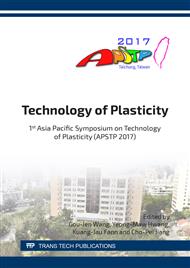[1]
I.M. Sas-Boca, M. Tintelecan, M. Pop, D.A. Ilutiu-Varvara, A.M. Mihu, The wire drawing process simulation and the optimization of geometry dies, Procedia Engineering, 181 (2017) 187-192.
DOI: 10.1016/j.proeng.2017.02.368
Google Scholar
[2]
L. Chevalier. Prediction of defects in metal forming: Application to wire drawing, Journal of Materials Processing Technology, 32 (1992) 145-153.
DOI: 10.1016/0924-0136(92)90171-n
Google Scholar
[3]
A. Haddi, A. Imad, G. Vega, Analysis of temperature and speed effects on the drawing stress for improving the wire drawing process, Material and Design, 32 (2011) 4310-4315.
DOI: 10.1016/j.matdes.2011.04.010
Google Scholar
[4]
P. Tiernan, M.T. Hillery, Dieless wire drawing-an experimental and numerical analysis, Journal of Materials Processing Technology, 155-156 (2004) 1178-1183.
DOI: 10.1016/j.jmatprotec.2004.04.175
Google Scholar
[5]
P. Tiernan, M.T. Hillery, An analysis of wire manufacture using the dieless drawing method, Journal Manufacturing Processes, 10 (2008) 12-20.
DOI: 10.1016/j.manpro.2008.05.001
Google Scholar
[6]
Y. Tang, D.S. Ou, Z.P Wan, L.S. Lu, B. Lian, Influence of drawing process parameters on forming of micro copper tube with straight grooves, Transactions of Nonferrous Metals Society of China, 21 (2011) 2264-2269.
DOI: 10.1016/s1003-6326(11)61006-6
Google Scholar
[7]
A. El-Domiaty, S.Z. Kassab, Temperature rise in wire-drawing, Journal of Materials Processing Technology, 83 (1998) 72-83.
DOI: 10.1016/s0924-0136(98)00045-4
Google Scholar
[8]
J.P. Kleinermann, J.P. Ponthot, Parameter identification and shape/process optimization in metal forming simulation, Journal of Materials Processing Technology, 139 (2003) 521-526.
DOI: 10.1016/s0924-0136(03)00530-2
Google Scholar
[9]
K.L. Wang, V. Argyropoulos, Design and analysis of direct cold drawing of section rods through a single die, Journal of Materials Processing Technology, 166 (2005) 345-358.
DOI: 10.1016/j.jmatprotec.2004.06.030
Google Scholar
[10]
J. F. Beland, M. Farard, A. Rahem, G. D'Amours, T. Cote, Optimization on the cold drawing process of 6063 aluminum tubes, Applied Mathematical Modelling, 35 (2011) 5302-5313.
DOI: 10.1016/j.apm.2011.04.025
Google Scholar
[11]
G.Y. Tzou, D.C. Chen, S.H. Lin, Study on wire rod drawing process using the rotating die, Key Engineering Materials, 716 (2016) 63-67.
DOI: 10.4028/www.scientific.net/kem.716.63
Google Scholar


